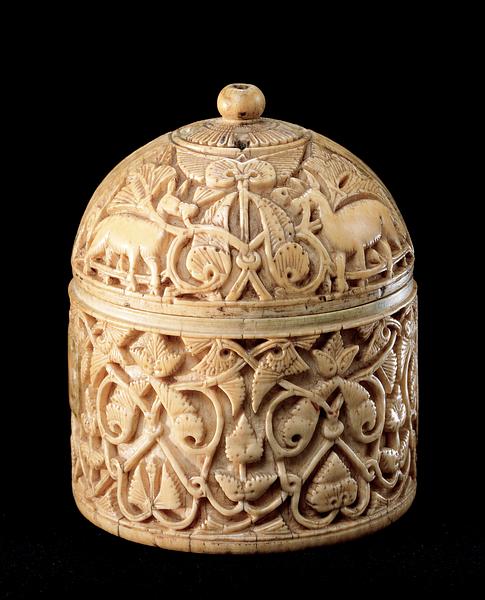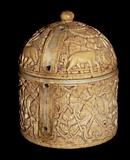Cylindrical box, carved ivory
Spain, Cuenca; 1st half of 11th century
H incl. lid: 7.1; Diam: 5.8 cm
Among the group of finely carved ivory boxes from the 10th-12th century are numerous cylindrical boxes, or pyxes, that in many cases have been preserved with their hemispherical lids. This little pyxis was carved with a repetitive pattern of vine scrolls on tendrils entwined in layers. On the lid, the pattern is combined with two symmetrically placed gazelle pairs that nibble on the vines.
The decoration is a slightly freer variant of the one found on another pyxis and on a box whose inscriptions say that it was made in Cuenca in around the middle of the 11th century.
After the fall of the Cordoba Caliphate, Cuenca briefly assumed its role as the most important Spanish production center for ivory objects.
Inv. no. 45/1998
Published in:
Georges Salles: Adolphe Stoclet collection, Brussel 1956, p. 152;
Éric Delpont (ed.): Les Andalousies de Damas à Cordoue, Institut du monde arabe, Paris 2000, cat.no. 163, p. 149;
Sophie Makariou: L'Andalousie arabe, Paris 2000, p. 27;
Kjeld von Folsach: Art from the World of Islam in The David Collection, Copenhagen 2001, cat.no. 406;
Sophie Makariou: ”L'ivoirerie de la Péninsule Ibérique aux XIe-XIIe siècles: entre Andalus et Hispania” in Les cahiers de Saint-Michel de Cuxa, 35, 2004, pp. 78-79;
Kjeld von Folsach: “A recently acquired Cordovan ivory casket in the David Collection” in Journal of the David Collection, 2005, 2:2, p. 117;
Journal of the David Collection, 2005, 2:2, cat.no. 26, pp. 336-337;
Ángel Galán y Galindo: Marfiles medievales del islam, Córdoba 2005, no. 03009, pp. 88-89;
Sheila S. Blair and Jonathan M. Bloom (eds.): Cosmophilia. Islamic Art from the David Collection, Copenhagen, McMullen Museum of Art, Boston College, Boston 2006, cat.no. 77;
Ángel Galán y Galindo: “Después de los marfiles califales cordobeses, (1. Parte): marfiles hispano-árabes, siglos XI Y XII. Periodos taifa y africanos” in Arte, Arqueología e Historia, 2008, 15, p. 64, no. 03009;
Mariam Rosser-Owen: “The metal mounts on Andalusi ivories: initial observations” in Venetia Porter and Mariam Rosser-Owens (eds.): Metalwork and material culture in the Islamic world : art, craft and text : essays presented to James W. Allan, London 2012, p. 312, note 36 (no photo);
Kjeld von Folsach: Flora islamica: plantemotiver i islamisk kunst, Davids Samling, København 2013, cat.no. 10;
Noelia Silva Santa-Cruz: La eboraria andalusí del califato omeya a la Granada nazaríi, Oxford 2013, cat.no. 33, pp. 299-300, figs. 154a-d, and p. 268;


.jpg?locale=en)